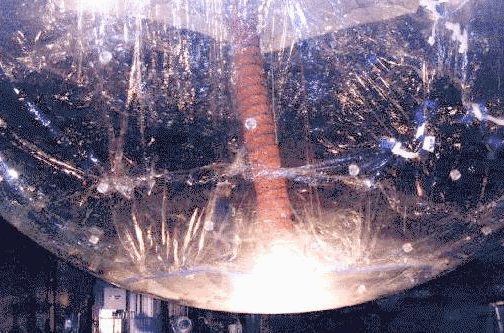Neutrinos created deep inside the Sun can change from one type to another as they stream towards Earth, according to the first results from the Sudbury Neutrino Observatory in Canada. The shortfall in the number of solar neutrinos observed in the last 30 years had cast doubt on the so-called standard solar model. But the new results confirm instead that electron neutrinos can 'oscillate' into muon and tau neutrinos and vice versa. Such oscillations can only occur if neutrinos have mass. Scientists from the Sudbury Neutrino Observatory presented their findings today at the Canadian Association of Physicists Annual Conference in Victoria and at seminars in the UK and US.

The Sun only produces electron neutrinos, but experiments have only detected half of the predicted number so far. If these neutrinos change their type, this would explain the shortfall. Previous experiments had failed to demonstrate this. While particle physicists must now attempt to incorporate this ‘oscillation’ into the Standard Model, solar scientists can breathe more easily. “We are now highly confident that the discrepancy is not caused by flaws in models of the Sun but by changes in the neutrinos themselves”, says Art McDonald, director of the SNO project.
The SNO project counts electron neutrinos by the telltale flashes of light they induce when they travel through heavy water. Deuterium – which contains an extra neutron – replaces ordinary hydrogen in heavy water, but it ionizes in the same way. When a neutrino collides with a deuterium nucleus it converts the neutron to a proton and ejects an energetic electron, which then emits Cherenkov radiation. Since the intensity of this radiation is related to the energy of the neutrino, the energy distribution of the incoming neutrinos can be calculated by the array of nearly 10 000 photomultipliers that monitor the flashes. About 10 neutrinos each day were detected by the current set-up. To date the SNO detector has counted only electron neutrinos, but a recent modification will enable it to count muon and tau neutrinos in the next experiment.
The SNO detector is located 2000 metres underground in an old mine shaft. Around 100 scientists from Canada, the US and the UK work on the project, which has been operating since 1998 and was conceived 14 years earlier. “It is incredibly exciting, after all these years spent by so many people, to see such intriguing results coming out of our first data analysis”, says team member David Wark of the Rutherford Appleton Laboratory and Sussex University in the UK, “and there is so much more to come”.
Scientists from SNO combined their data with results from the Super-Kamiokande (SK) experiment in Japan to establish an upper limit on the mass of neutrinos. Over a three-and-a-half year period, the SK project detected only 45% of the solar neutrino flux predicted by theory. The SK experiment used a lower energy threshold than previous studies, which enabled it to detect a greater proportion of lower-energy electron neutrinos and a small number of muon and tau neutrinos (S Fukuda et al 2001 Phys. Rev. Lett. 86 5651, 5656).



